
ARE 5.0 Project Management (PjM) Study Guide
Learn to organize, manage, and coordinate architectural projects—including contracts, schedules, and team resources—with expert-led study materials designed for exam success.
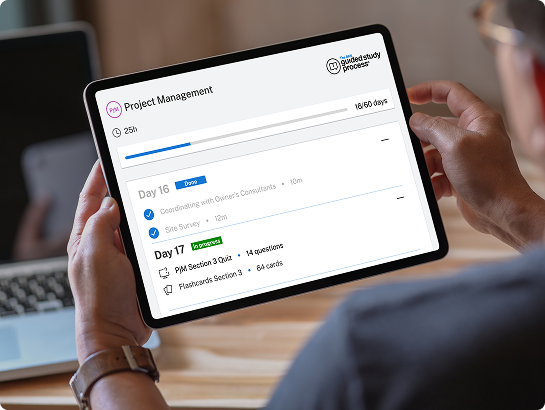
PjM Pass Rates 48% Higher Than NCARB Average
Black Spectacles testers pass PjM 89% vs the NCARB average of 60%
Students who prepare with Black Spectacles pass the PjM exam at rates up to 48% higher than the national average.
Our proven study system combines practice exams that mirror the real NCARB exam, expert-led video lectures, quiz breaks built into each lesson, and flashcards directly tied to key lecture terms—so you can learn faster, retain more, and walk into test day with total confidence.
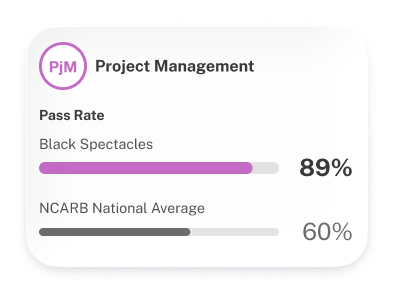
What is the Project Management (PjM) Exam?
The PjM division of the Architect Registration Examination (ARE 5.0) tests your ability to manage project execution — from contracts and budgets to staffing, scheduling, and consultant coordination.
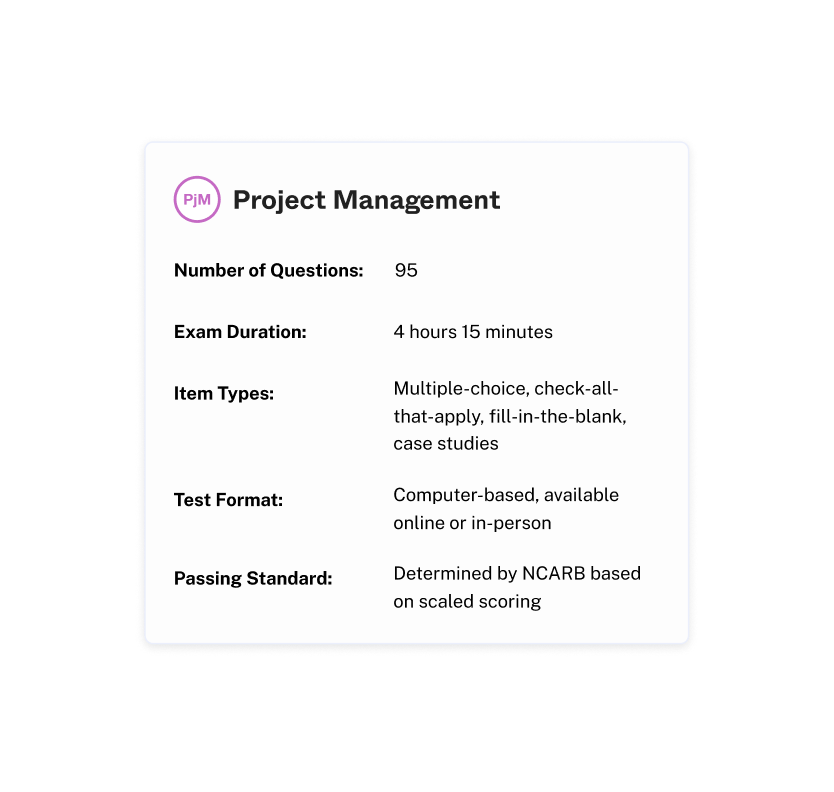
Exam Format and Structure
The PjM exam focuses on project delivery and management tasks, assessing how well you can apply professional standards and coordinate all aspects of an architectural project.
Pass Rates and Statistics
National pass rates for PjM typically average around 60%, but Black Spectacles students consistently outperform this through focused, efficient study strategies.
Exam Duration and Question Types
You’ll have 4 hours and 15 minutes to complete 95 questions, including case studies, check-all-that-apply questions, and scenario-based items.
What the PjM Exam Covers
1. Resource Management
Tests your ability to manage staff, consultants, and budgets to ensure efficient project delivery.
2. Project Work Planning
Covers creating schedules, scopes, and work plans that align with firm resources and project goals.
3. Contracts and Project Execution
Focuses on managing project agreements, including client and consultant contracts, and understanding roles and responsibilities during project delivery.
4. Quality Control
Assesses your understanding of risk management, document review, and communication strategies that support successful outcomes.
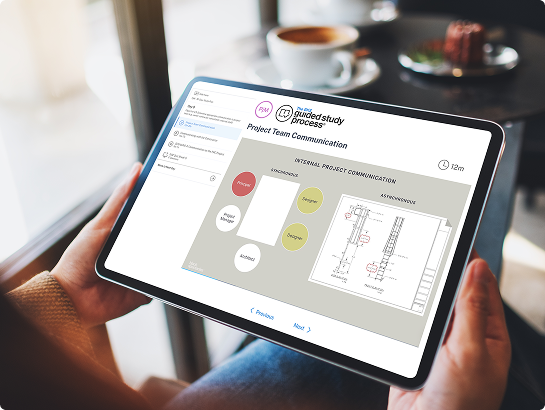
What's Unique about the PjM
Project Management focuses on the entire lifecycle of a signed project—from assembling your team to delivering completed work. Unlike Practice Management's focus on running a firm, PjM tests your ability to coordinate consultants, manage contracts, maintain schedules, and control quality throughout an actual project. The exam emphasizes applying contract knowledge to real project scenarios.
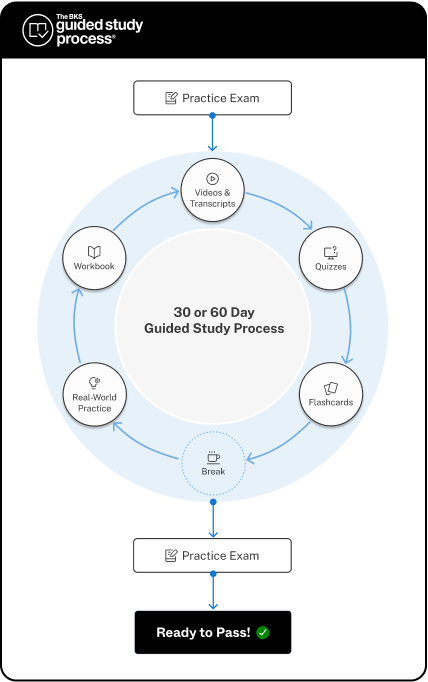
Recommended Study Timeline
Most candidates spend 6–8 weeks preparing for PjM. Break your study plan into weekly goals and milestones using our built-in Guided Study Process to stay organized and on track.
- Weeks 1-2: Focus on Sections 1-2 (Resource Management and Project Work Planning). Learn how to assemble project teams, develop work plans, and create project schedules. Use video lectures to understand Critical Path Method and flashcards to memorize scheduling terminology.
- Weeks 3-4: Study Section 3 (Contracts)—the largest portion of the exam. Master AIA B101 (Owner-Architect Agreement) and A201 (Owner-Contractor Agreement). Our practical application videos break down complex contract language into exam-ready knowledge.
- Weeks 5-6: Cover Sections 4-5 (Project Execution and Project Quality Control). Practice applying quality control procedures and managing project budgets using quizzes that test cross-sectional understanding.
- Weeks 7-8: Take full-length practice exams under timed conditions. PjM questions often involve contract interpretation, so review AIA documents alongside your practice test results.
Recommended Study Timeline
Black Spectacles offers two ways to prepare:
- Guided Study provides a structured plan aligned with your exam schedule, helping you stay focused with clear daily tasks and milestones.
- Flexible Study gives you the freedom to move through the material at your own pace and in any order that fits your learning style.
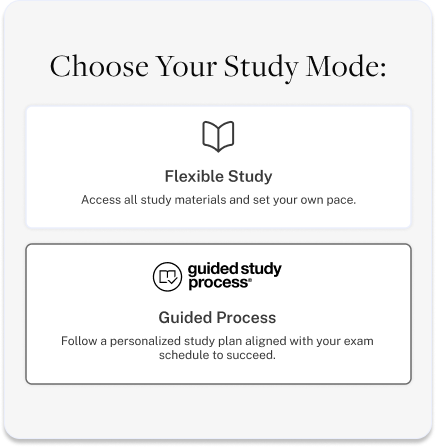
Black Spectacles PjM Study Materials
Expert-Led Study Materials
Black Spectacles provides a complete ecosystem of study resources created by licensed architects who understand your challenges. Our comprehensive study platform includes:
![]() Video lectures that break down complex topics into manageable segments
Video lectures that break down complex topics into manageable segments
![]() Practice tests mirroring the actual exam format and difficulty
Practice tests mirroring the actual exam format and difficulty
![]() Digital flashcards for quick review sessions
Digital flashcards for quick review sessions
![]() Real-World Practices to help you work through difficult problems live, with the support of your peers and a registered architect coach.
Real-World Practices to help you work through difficult problems live, with the support of your peers and a registered architect coach.
![]() The Guided Study Process organizes your study content into daily, manageable study time, including breaks, that align with your exam date.
The Guided Study Process organizes your study content into daily, manageable study time, including breaks, that align with your exam date.
There is a science to learning.
There is an optimal way to study.
2x Faster Licensure
Black Spectacles members report completing licensure in half the time of the NCARB average.

40% Higher Pass Rate
Our pass rate surpasses the national average by more than 40%

Ready to Pass the PjM Exam?
Strategic Exam Order: Your Blueprint for Success
While NCARB allows candidates to take the divisions in any order, analysis of thousands of successful candidates reveals clear patterns for success. We recommend this strategic sequence:
Your Road to Licensure in 12 Months
Month 1
PcMMonth 2
PjMMonth 3
PAMonth 4

Break

Retake
Month 5 - Month 6
PPDMonth 7 - Month 8
PDDMonth 9

Break

Retake
Month 10
CEMonth 11

Break

Retake
Month 12
 Licensed
Licensed
Frequently asked questions
How long should I study for the PjM exam?
Most candidates spend 6–8 weeks preparing, studying around 10–15 hours per week.
What is a passing score for the PjM exam?
NCARB uses a scaled score system. You’ll need to meet or exceed the passing threshold set for your version of the exam.
Is the PjM exam hard?
The PjM exam covers project execution, contracts, and coordination — areas that require both technical and managerial knowledge. With the right study tools, you can pass with confidence.
Can I take the PjM exam online?
Yes. NCARB offers both in-person and online proctored options for all ARE 5.0 divisions, including PjM.
How can Black Spectacles help me pass?
Black Spectacles provides a complete suite of ARE 5.0 study materials—featuring video lectures, practice exams, flashcards, and a guided study process designed to help you master every topic tested on the PjM exam.